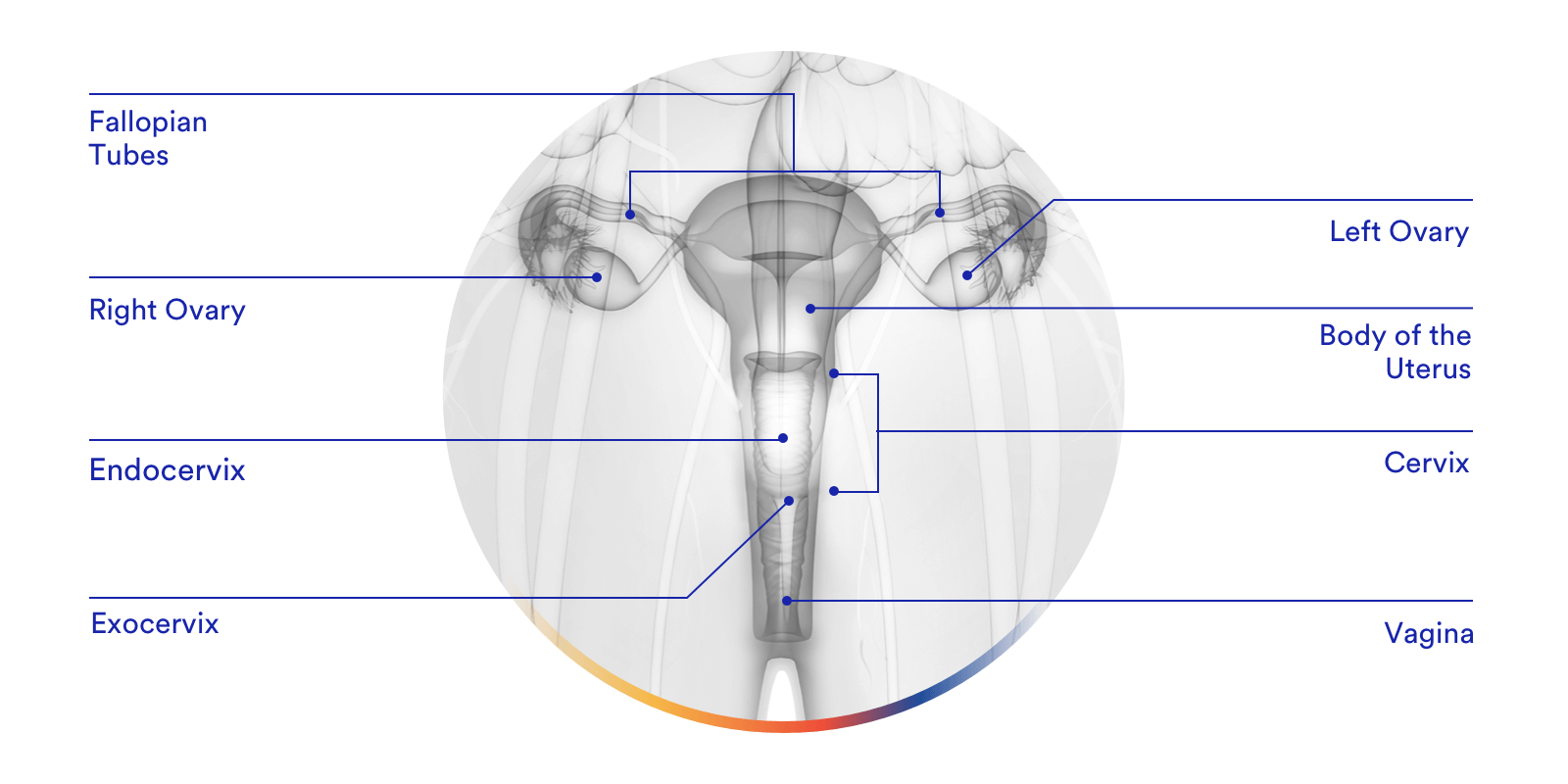
Ovarian Cancer, Fallopian Tube Cancer or Primary Peritoneal Cancer
What is cancer of ovaries, fallopian tube or peritoneum?
Ovarian, fallopian tube and primary peritoneal cancer originate in the same kind of tissue and are treated in the same way.
Ovaries are a pair of reproductive organs in women, each about the size of an almond, situated on either side of the uterus (womb). They produce eggs (ova) for reproduction and also produce the female hormones- oestrogen and progesterone. Fallopian tubes are pair of long, slender tubes, one on each side of the uterus. Eggs pass from the ovaries, through the fallopian tubes, to the uterus. Peritoneum is the tissue that lines the abdominal wall and covers organs in the abdomen. Cancer of the ovaries is the eighth most commonly occurring cancer in women worldwide. Cancer of ovary, fallopian tube and primary peritoneum originate in the same kind of tissue and are treated in the same way. Primary peritoneal cancer is cancer that forms in the peritoneum and has not spread there from another part of the body. Cancer sometimes begins at the end of the fallopian tube near the ovary or in the peritoneum and spreads to the ovary.
Which factors are known to reduce risk of ovarian and associated cancers?
There is no definite answer to this. However, a lot of research evidence tells us that factors which reduce ovulation may also reduce the risk of ovarian cancer.
These factors include:
- Pregnancy & breastfeeding : Women who have had a full-term pregnancy before age 26 are at lower risk, with risk decreasing further with each full-term pregnancy. Breastfeeding also lowers risk.
- Birth control : Birth control measures such as use of oral contraceptives (pill), tubal ligation, use of IUDs (intrauterine devices) lowers risk of ovarian cancer.
- Hysterectomy : The risk of ovarian cancer is lower among women who have undergone hysterectomy compared with those who have not. The protection however seems to go down with time.
Carefully controlled cell division and cell destruction continuously happen inside the ovaries. But, when some cells divide uncontrollably, and can’t respond to signals that tell it to stop dividing, a tumour is said to have formed in the ovary. Ovarian cancer is the eighth most commonly occurring cancer in women worldwide. In 2018 alone, about 3.0 million new cases of ovarian cancer was reported. Ovarian cancer can start from 3 types of cells: Epithelium (cell covering outer lining of ovaries), Germ cells (cells that eventually form eggs) and Stromal cells (cells that release hormones and connect different structures of ovaries).
All tumours in the ovary are however not cancerous. Some are non-cancerous (benign) and never spread beyond the ovary. However, borderline (may turn cancerous) and malignant (cancerous) tumours can invade through the ovary to surrounding tissues.
Abbreviations
AJCC: American Joint Committee on Cancer CT scan: Computed Tomography scan EBRT: External beam radiation therapy FIGO: International Federation of Gynecology and Obstetrics HRT: Hormone replacement therapy LHRH: Luteinizing hormone-releasing hormone NCI: National Cancer Institute PARP: Poly (ADP-ribose) polymerase PET scan: Positron emission tomography scan TNM: Tumor, node, metastasis staging system
References
- What is ovarian cancer?, American Cancer Society, Available at: https://www.cancer.org/cancer/ovarian-cancer/about/what-is-ovarian-cancer.html, Accessed on 15.02.2019
- Bray, F., Ferlay, J., Soerjomataram, I., Siegel, R. L., Torre, L. A., & Jemal, A. (2018). Global cancer statistics 2018: GLOBOCAN estimates of incidence and mortality worldwide for 36 cancers in 185 countries. CA: A Cancer Journal for Clinicians, 68(6), 394-424. doi:10.3322/caac.21492
- Timing of Pregnancy and the Risk of Epithelial Ovarian Cancer, David C. Whiteman, Victor Siskind, David M. Purdie and Adèle C. Green, Cancer Epidemiol Biomarkers Prev January 1 2003 (12) (1) 42-46
- Loft A, Lidegaard O, Tabor A. (1997). Incidence of ovarian cancer after hysterectomy: a nationwide controlled follow up. Br J Obstet Gynaecol, 104(11), 1296-301. Retrieved from https://obgyn.onlinelibrary.wiley.com/doi/pdf/10.1111/j.1471-0528.1997.tb10978.x
- Ovarian Cancer Risk Factors, American Cancer Society, Available at: https://www.cancer.org/cancer/ovarian-cancer/causes-risks-prevention/risk-factors.html, Accessed on 18.02.2019
- Foong, K. W., & Bolton, H. (2017). Obesity and ovarian cancer risk: A systematic review. Post Reproductive Health, 23(4), 183-198. doi:10.1177/2053369117709225
- Stewart, L. M., Holman, C. D., Aboagye-Sarfo, P., Finn, J. C., Preen, D. B., & Hart, R. (2013). In vitro fertilization, endometriosis, nulliparity and ovarian cancer risk. Gynecologic Oncology, 128(2), 260-264. doi:10.1016/j.ygyno.2012.10.023
- HRT and Cancer, Cancer Research UK, Available at: https://www.cancerresearchuk.org/about-cancer/causes-of-cancer/hormones-and-cancer/hrt-and-cancer Accessed on: 18.02.2019
- Frank, T. S. (1999). Testing for Hereditary Risk of Ovarian Cancer. Cancer Control, 6(4), 327-334. doi:10.1177/107327489900600401
- Symptoms: Ovarian Cancer, National Health Service (NHS), UK, Available at: https://www.nhs.uk/conditions/ovarian-cancer/symptoms/ Accessed on: 18.02.2019
- Frank, T. S. (1999). Testing for Hereditary Risk of Ovarian Cancer. Cancer Control, 6(4), 327-334. doi:10.1177/107327489900600401
- Ovarian Cancer Stages, American Cancer Society, Available at: https://www.cancer.org/cancer/ovarian-cancer/detection-diagnosis-staging/staging.html Accessed on 19.02.2019
- Treatment, Target Ovarian Cancer, UK, Available at: https://www.targetovariancancer.org.uk/information-and-support/my-ovarian-cancer-has-come-back/treatment Accessed on 12.06.2019




